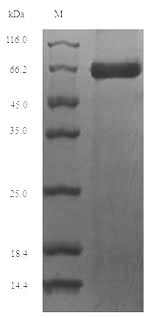Recombinant Mouse Perforin-1 (Prf1) is produced in E. coli and spans the full length of the mature protein from amino acids 21 to 554. The protein includes an N-terminal 6xHis-tag, which makes purification and detection more straightforward. SDS-PAGE analysis shows the product reaches greater than 85% purity, which appears to provide reliable performance in experimental applications. This product is intended for research use only and has not been assessed for endotoxin levels.
Perforin-1 represents a critical component in immune responses. It's primarily involved in the cytotoxic activity of lymphocytes. The protein plays what seems to be a pivotal role in target cell lysis by forming pores in target cell membranes. For researchers studying immune cell function and related pathways, this protein may prove to be a valuable tool in immunological research.
Potential Applications
Note: The applications listed below are based on what we know about this protein's biological functions, published research, and experience from experts in the field. However, we haven't fully tested all of these applications ourselves yet. We'd recommend running some preliminary tests first to make sure they work for your specific research goals.
The mouse Prf1 is a complex pore-forming protein that requires precise folding, calcium-dependent conformational changes, and proteolytic activation for bioactivity. E. coli, as a prokaryotic system, lacks the eukaryotic chaperones and post-translational modification machinery necessary for proper folding of this complex immune protein. Critically, Prf1 must undergo proteolytic cleavage to become active, which E. coli cannot perform. The His tag may improve solubility, but cannot compensate for these fundamental limitations. Without experimental validation, this protein is highly unlikely to be correctly folded or bioactive.
1. Antibody Development and Validation Studies
This recombinant Prf1 can serve as an immunogen for antibody production against linear epitopes, as antibodies often recognize denatured sequences. The His tag facilitates purification. However, antibodies generated may not recognize native, properly folded and activated Prf1 in cytotoxic granules. Validate antibody specificity against native Prf1 from mouse cytotoxic lymphocytes.
2. Protein-Protein Interaction Studies
Not recommended without folding validation. Prf1 requires correct folding for physiological interactions (e.g., with granzymes or membrane lipids). Misfolded Prf1 may yield non-physiological interactions. The His tag may cause artifactual binding. Use native Prf1 from mammalian systems for interaction studies.
3. Biochemical Characterization and Stability Studies
Suitable for basic biophysical analysis of the recombinant Prf1 protein's properties (e.g., aggregation state by DLS). However, data will reflect the E. coli-expressed Prf1 protein, not native Prf1. Do not extrapolate results to physiological Prf1 behavior.
4. ELISA-Based Quantification Assays
It can be used as a standard for detecting Prf1 linear epitopes, but will not accurately quantify native, functional Prf1. Misfolded protein may not be recognized by conformation-specific antibodies. Always validate with native standards.
Final Recommendation & Action Plan
This E. coli-expressed Prf1 is unsuitable for functional studies without rigorous validation. First, test if the protein can bind calcium or undergo conformational changes using circular dichroism. However, expect limited functionality. For reliable results, use Prf1 expressed in mammalian systems (e.g., HEK293 cells) that can perform necessary proteolytic processing and folding. Reserve this E. coli protein for antibody production against linear epitopes, but validate thoroughly against native Prf1.






